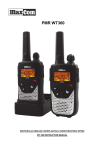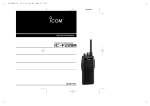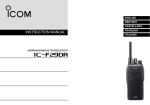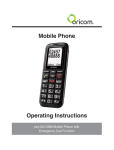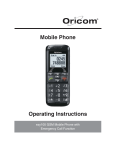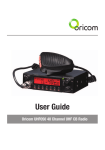Download Oricom PMR1200 User's Manual
Transcript
® Operating Instructions PMR1200 40 Channel UHF 2 Way Citizen Band Radio ® Table of contents Safety Information and Warnings.................................... 4 Getting Started............................................................... 8 Oricom PMR1200 instructions...................................... 12 Operation...................................................................... 13 UHF channels and frequencies...................................... 22 Warranty information (Australia).................................... 24 Customer support......................................................... 26 This unit complies with all relevant Australian and New Zealand approval requirements including radio communications (Electromagnetic Radiation Human Exposure) standard 2003. 3 Safety Information and Warnings Safety Information and Warnings WARNING 4 Information on Safe Operation Read This Information Before Using Your Oricom Radio. Radio Antenna Do not use any radio that has a damaged antenna. If a damaged antenna comes in contact with the skin, a minor burn may result. Unauthorized antennas, modifications, or attachments could damage the radio and violate compliance. Do NOT change or modify the antenna. Do NOT hold the antenna when the radio is “IN USE.” Holding the antenna reduces range and may cause bodily harm. Safety and general use whilst in a vehicle Check the State and Federal laws and regulations regarding the use of two way radios in the area where you drive, and always obey them. For Vehicles fitted with Air Bags Do not place your radio in the area over an air bag or in the air bag deployment area. Air bags inflate with great force. If a radio is placed in the air bag deployment area and the air bag inflates, the radio may be propelled with great force and cause serious injury to the occupants of the vehicle. Batteries All batteries can cause property damage and/or bodily injury such as burns if conductive material such as jewelry, keys, or beaded chains touches exposed terminals. The material may complete an electrical circuit (short circuit) and become quite hot. Exercise care in handling any charged battery, particularly when placing it inside a pocket, purse, or other container with metal objects. Do not replace or charge batteries in a potentially explosive atmosphere. Contact sparking may occur while installing or removing batteries and cause an explosion. Safety Information and Warnings WARNING Potentially Explosive Atmospheres Turn your radio OFF when in any area with a potentially explosive atmosphere. Sparks in such areas could cause an explosion or fire resulting in injury or even death. NOTE: Areas with potentially explosive atmospheres are often, but not always clearly marked. They include fueling areas such as below deck on boats; fuel or chemical transfer or storage facilities; areas where the air contains chemicals or particles, such as grain, dust, or metal powders; and any other area where you would normally be advised to turn off your vehicle engine. Blasting Caps and Areas To avoid possible interference with blasting operations, turn your radio OFF near electrical blasting caps or in a “blasting area” or in areas posted: “Turn off the two way radio.” Obey all signs and instructions. Exposure to Radio Frequency Energy Your Oricom two-way radio complies with Australian Communications Authority Radio communications (Electromagnetic Radiation-Human Exposure) Standard, 2003. To assure optimal radio performance and make sure human exposure to radio frequency electromagnetic energy is within the guidelines set out in the above standards always adhere to the following procedures. Transmit and Receive Procedure Your two-way radio contains a transmitter and a receiver. To control your exposure and ensure compliance with the general population/uncontrolled environment exposure limits, always adhere to the following procedure: • Transmit no more than 50% of the time. • To receive calls, release the PTT button. • To transmit (talk), press the Push to Talk (PTT) button. Transmitting 50% of the time, or less, is important because the radio generates measurable RF energy exposure only when transmitting (in terms of measuring standards compliance). Always hold the radio approximately 5cm in front of your mouth with the antenna pointing away from your head. 5 Safety Information and Warnings WARNING 6 Radio Operation and EME Exposure Unauthorized antennas, modifications, or attachments could damage the radio and violate compliance. Do NOT hold the antenna when the radio is “IN USE.” Holding the antenna reduces the effective range. Do not use the radio if the antenna is damaged. If a damaged antenna makes contact with your skin, a minor burn can result. If you wear a radio on your body when transmitting, always fit the radio on the belt clip (supplied). Always ensure the radio and it's antenna are at least 5cm from your body when transmitting. Electromagnetic Interference/Compatibility Nearly every electronic device is susceptible to electromagnetic interference (EMI). To avoid the possibility of electromagnetic interference and/or compatibility conflicts, turn off your radio in any location where posted notices instruct you to do so such as health care facilities. Aircraft When instructed to do so, turn off your radio when onboard an aircraft. Any use of a radio must be in accordance with applicable regulations per airline crew instructions. Safety Information and Warnings WARNING Medical Devices - Pacemakers The Advanced Medical Technology Association recommends that a minimum separation of 6 inches (15cm) be maintained between a handheld wireless radio and a pacemaker. These recommendations are consistent with the independent research by and recommendations of the U.S. Food and Drug Administration. People with pacemakers should: • ALWAYS keep the radio more than 15cm from their pacemaker when the radio is turned ON. • N ot carry the radio in the breast pocket. • U se the ear opposite the pacemaker to minimize the potential for interference. • Turn the radio OFF immediately if there is any reason to suspect that interference is taking place. Medical Devices - Hearing Aids Some radios may interfere with some hearing aids. In the event of such interference, you may want to consult your hearing aid manufacturer to discuss alternatives. Other Medical Devices If you use any other personal medical device, consult the manufacturer of your device to determine if it is adequately shielded from RF energy. Your physician may be able to assist you in obtaining this information. General warnings Never use your radio outdoors during a thunderstorm. Keep the radio out of reach of babies and young children. 7 Getting Started Installation Removing the Belt Clip Pull the Belt Clip latch forward (away from the unit) While pulling the Belt Clip latch, push up the Belt Clip as shown in Figure1. Belt Clip latch Installing the Belt Clip Slide the Belt clip into the slot as shown in Figure2. A “click” indicates the Belt clip is locked into position. Installing the Batteries Figure 3 Figure 1 Figure 2 Figure 4 Caution: O bserve the proper battery polarity orientation when installing batteries. Incorrect positioning can damage both the batteries and the unit. a. Slide down the Battery Compartment Cover. b. Install the rechargeable batteries by following the orientation as shown in Figure 3 (the arrow is showing and pointing upward.) c. Replace the Battery Compartment Cover. See Figure 4. 8 Getting Started Important Read these Safety Warnings before you charge the batteries. When placing the radio in the charger, use only the power supplies listed in the user instructions supplied with the unit. Don’t try to recharge non-rechargeable batteries. Make sure the battery compartment cover is securely locked in place when you are charging the batteries. Dispose of used batteries safely and in a way that will not harm the environment- never try to burn them or put them anywhere, they could get burnt or punctured. Don’t leave dead batteries in your radio. They might leak if you do. Charging the battery pack a. Insert the small plug in the end of the mains adaptor into the Power-in Connection Jack at the back of the desktop charger. b. Plug the mains adaptor into a 240V AC, 50Hz main socket with the switch on the socket set to OFF. c. Switch ON the main socket. The radio must be charged using the mains adaptor provided. Using any other adaptor will invalidate any approvals & warranty. d. Place the radio units in the charge cradle in an upright position and facing outward. The Charge LED indicators will light up. e. It takes about 10 hours to fully recharge the batteries if the battery are completely run down. New batteries take up to 14 hours to fully charge. Main socket Important: Always turn off the radio units when charging. This will shorten the charging time. 9 Getting Started f. Charging the battery pack (using adaptor) Lift the charge socket cover located on the right side of the handset. Insert the round connector of the 9.0V DC/200mA adaptor into the charge jack. Mic/spk jack Charge jack Plug the mains adaptor into a 240V AC, 50Hz main socket with the switch on the socket set to OFF. Then switch ON the main socket. Battery meter The battery meter is located in the left corner of the LCD screen. It appears like a battery with three bars inside. These indicate the amount of power available. When the battery level reaches it minimum level, the unit will emit two beep tones and automatically it will power off. Your PMR1200 can detect the battery charge in 4 levels; Battery charge at high level. Battery charge at medium level. Battery charge at low level. At this level, the radio will emit a “beep” sound for every 10 seconds in standby mode. TIP: At this stage, you need to recharge the unit at once, otherwise the battery will run down totally. Battery charge at very low level. When the battery level reaches its minimum level, the unit will emit two beep tones and automatically turn off the power. Important: You need to charge the unit for 10-14 hours. CAUTION: R isk of explosion if battery is replaced by an incorrect type. Dispose of used batteries according to the instructions. 10 Getting Started Battery life Your radio has a built in power saver to make the batteries last longer. But when you are not using the units, turn them OFF to conserve battery power. For in vehicle charging the accessory kit SM5100 contains 2 car chargers and 2 shoulder speaker mics. These can be purchased from your re-seller or online at www.oricom.com.au Transmitting range The talk range depends on the environment and terrain. The radio can reach (up to about 7km) in wide open spaces, without obstructions such as hills or buildings. Don’t try to use two radio units which are less than 1.5m (5 feet) apart. Otherwise, you may experience interference. Talk range depends on the terrain. It will be affected by concrete structures, heavy foliage and by operating radios indoors or in vehicles. Optimal Range Outdoors Flat, open areas Medium Range Outdoors Buildings or trees Also near residential buildings Minimal Range Outdoors Dense foliage or mountains. Also inside some buildings 11 Oricom PMR1200 instructions Oricom PMR1200 2 Way CB Radio Antenna LCD Screen - Displays the current channel selection and other radio symbols. PTT (PUSH to TALK) button - Press and hold to transmit. CALL button - Press to send ringing tone to other PMR units. MENU Button - Press to change and switch between other modes. Speaker Receiver LED - lights up when you Are receiving signals. Ear/Mic/Charge jack PWR(POWER) Button - Press and hold to turn the unit ON or OFF. MIC (Microphone) UP/DOWN Buttons - Press to change channels, volume, and to select settings during programming. LCD Screen RPT 12 hannel Number. Changes from 1 to 40 as C selected by the user. CTCSS Code. Changes from 1 to 38 as selected by the user. Displays the Battery change level. When the bars are reduced, the battery needs recharging. Displayed when transmitting a signal. Displayed when receiving a signal. Displayed when the Dual Watch function is turned ON. Displayed when the VOX feature is enabled. Displays when scanning is activated. Displayed when the Key Lock feature is activated. Displays the current Speaker volume level. Displays when Digital code system is setting. Displayed when the repeater function is activated. Displays when Stopwatch function is activated. Operation Operation Turning the Unit ON/OFF To Turn ON; a. P ress and hold the POWER button until the LCD screen turns ON and displays the current channel. To switch OFF; b. Press and hold the POWER button until the LCD screen turns blank. Changing Channels The PMR1200 has 40 available channels, to communicate with other radio’s, it must have your radio tuned to the same channel. a. P ress the MENU button once, the current channel number flashes on the LCD Screen. b. Press the UP or DOWN button to select the desired channel. The channel changes from 1 to 40, or vice versa. c. P ress the PTT button to confirm the channel setting. These are paired with higher channels as output/input (1/31, 2/32, etc.) Check for local repeater activity before using these channels in Simplex mode to avoid interference. Channels 9 and above are the best choices for general use in Simplex mode. You can find more information about channels and frequencies by visiting the Web site http://www.acma.gov.au Note: Refer to the “Channel Table” section of this Owner’s Manual for detailed frequency listing. Setting the CTCSS sub-channel Each channel has 38 sub-channels to let you set up group of users within the same channel for more private communication. If you have set the sub-channel, you can only communicate with other radio users tuned to the same channel and sub-channel I. 13 Operation To turn the sub-channel function off, simply set the subchannel to 0 (zero). You can then communicate with other radio’s setting to the same channel who also turns off the sub-channel operation (or whose unit does not have the sub-channel feature). a. Press the MENU button twice, the current CTCSS subchannel number flashes on the LCD screen. b. Press the UP or DOWN button to select one of the 38 CTCSS sub-channels. c. P ress the PTT button to confirm the CTCSS sub-channel setting. SETTING THE DCS ADVANCED DIGITAL CODE. Each channel also has 83 digital codes to let you set a group of users for more secured private communication. a. P ress the MENU button 3 times. DCS code is blinking on the LCD screen. b. Press the UP or DOWN button to select the desired DCS code. c. P ress the PTT button to confirm the DCS channel setting. Transmitting and Receiving The PMR1200 transmission is SIMPLEX “one way-ata-time.” While you are speaking, you can not receive a transmission. The PMR1200 is an open-license band. Always identify yourself when transmitting on the same channel. IMPORTANT: B efore transmitting on a UHF channel listen to ensure it is not already in use. 14 Operation Transmitting (sending speech) The unit is continuously in the Receive mode when the unit is turned ON and not transmitting. When a signal is received on the current channel, “RX” icon will be displayed on the LCD screen and the receiver LED will light up. a. P ress and hold the PTT (push to talk) button to transmit your voice. “TX” icon will be displayed on the LCD Screen. b. H old the unit in a vertical position with the MIC (Microphone) 5 cm away from the mouth. While holding the PTT button, speak into the MIC (microphone) in a normal tone of voice. c. R elease the PTT button when you have finished transmitting. Monitor You can use the Monitor feature to check for weak signals on the current channel. a. Press and hold the MENU and DOWN buttons at the same time. “ ” icon will be displayed on the LCD screen. Your radio will pick up signals on the current channel, including background noise. b. Press the MENU button to stop the channel monitoring. Setting the VOX (Voice Activated) Sensitivity In VOX mode, the radio will transmit a signal only when it is activated by your voice or other sounds around you. The unit will transmit further for 2 seconds even if you stop talking. The level of VOX sensitivity is shown by a number on the LCD Screen. At the highest level, the units will pickup softer noise (including background noise); at the lowest level, it will pick up only quite loud noise. 15 Operation a. Press the MENU button 4 times, “VOX” icon will be displayed and “OFF” flashes on the LCD screen. b. P ress the UP button to set the VOX sensitivity into maximum level (the maximum level is “3 ”.) To deactivate the VOX function, press the DOWN button until “OF” appears on the LCD Screen. c. P ress the PTT button to confirm your setting. “VOX” will steadily appear on the LCD Screen as along as the VOX feature is activated. VOX operation is not recommended if the radio will be used in a noisy or windy environment. A VOX headset is also available under part number KESP-300-0. This can be purchased from your re-seller on online at www.oricom.com.au Activating the Auto Channel Scan Channel scan perform searches for active signals in an endless loop for all 40 channels, 38 CTCSS codes and all 83 DCS codes. a. Press the MENU button 5 times, “SC” icon will display on LCD screen. b. P ress the UP or DOWN button to begin scanning channels when an active signal is detected, channel scan pauses on the active channel. c. Press the MENU button six times, CTCSS flashes on the LCD screen press the UP or DOWN button to begin scanning the CTCSS from 1-38. d. Press the MENU button seven times, DCS flashes on the LCD screen. Press the UP or DOWN button to begin scanning DCS code 1-83. e. Press the PTT button to confirm your setting. 16 Operation Call alert Your radio can alert you to incoming signal by emitting an audible call tone. Call-Ring tone You can send a Call-ring tone to other radio users to give an alert that you want to communicate with them. Press the CALL button You will hear a ring tone for about two seconds; “TX” icon appears on the LCD screen. Any other units within the transmitting range and tuned to the same channel and subchannel (if applicable) will hear the Call-ring tone. Selecting a Call- Ring tone Your PMR1200 is equipped with 10 different types of Call-Ring tones. a. Press the MENU button 8 times, the “C A” icon will display and flash on the LCD Screen. b. Press the UP or DOWN button to select the desired Callring tone. A respective Call- Ring tone sound will be played when changing from one tone to another. c. P ress the PTT button to confirm your setting. Setting the Roger Beep The Roger beep is a tone which is automatically transmitted whenever the PTT button is released. This alerts the receiving party to inform you that you have intentionally ended the transmission, and you are now in receive mode. a. P ress the MENU button 9 times, the “ON” icon will flash on the LCD Screen. b. P ress the UP or DOWN button to select the Roger beep On/Off. c. P ress the PTT button to confirm your setting. 17 Operation Setting the Key Tone ON or OFF This feature allows your radio unit to emit a confirmation tone after pressing each button. a. P ress the MENU button 10 times, the “ON” icon is flashing on the LCD Screen. b. P ress the UP or DOWN button to select Key tone On/Off. c. P ress the PTT button to confirm your setting. Setting the Dual Watch Mode Your radio is capable of monitoring two channels, the current and another (dual watch) channel. If the unit detects a signal on either channel, it will stop and receive the signal. a. Press the MENU button 11 times, “DCM” icon will be displayed while “OF ” flashes on the LCD Screen. b. P ress the UP or DOWN button to select the Dual Watch channel (1-40, except the current channel). c. C ontinue pressing the MENU button to change the CTCSS code. d. Press the UP or DOWN button to select the desired CTCSS code (1-38) e. Continue pressing the MENU button to change the DCS code. f. Press the UP or DOWN button to select the desired DCS code (1-83) g. Press the PTT button to confirm your setting. Duplex operation via Repeaters This feature allows to use local repeater stations that are designed to automatically re-transmit your broadcast over a large area thus giving you increased range. Repeaters stations are privately operated radio systems installed throughout Australia. You can see a list of repeater sites by following this link to our website (note this list is always being updated) 18 Operation http://www.oricom.com.au/support/repeater or visit http://www.tropinet.com/uhf-repeaters/ For example, if you wish to access a repeater station in your area which operates on channel 2 you only need to set the Duplex access on this Channel. So, if you are in the range of a local repeater which transmits on channel 2, after setting your radio to allow access of the repeater on that channel, you will select channel 2 as normal, but during transmit operation your radio will automatically transmit to the repeater on channel 32. Turning on/off Duplex on channels a.Select the required channel to suit the repeater station you wish to access (Channels 1 – 8 only) b. Press the Menu button twice, “RPT” icon will display c.Press the UP or DOWN button to set the Duplex function to On or Off. d. Press the PTT button to confirm your setting. e.The RPT icon will display to indicate that Duplex is set on that channel. Receive Channel 1 2 3 4 5* 6 7 8 Transmit channel 31 32 33 34 35* 36 37 38 * Channel 5 is emergency channel only el 2 ann 32 Ch nnel a Ch Repeater Station Ch an ann nel 2 el 3 2 Ch 19 Operation Setting the Repeater function a. Press the Menu button 12 times, “RPT” icon will be displayed and flashing on the LCD screen. b. Press the UP or DOWN button to set the Repeat function to On or Off. c. P ress the PTT button to confirm your setting. Important •Speech transmissions are not allowed on channel 22 and 23 (Receive only) •CTCSS and Call ring tone calling should be disabled on channel 5 and 35. •If Call ring tone calling is provided, it is only allowed to operate for a maximum of 3 seconds and it can only be possible to operate once in any 60 second period. Auxiliary Features Key Lock The Key Lock feature allows the user to disable the UP, DOWN and MENU buttons so that the PMR1200 settings could not be changed accidentally. a. To activate the key Lock feature, press and hold the MENU button until key lock “ ” icon appears on the LCD Screen. b. To deactivate the key Lock feature, press and hold the MENU button until key lock “ ” icon disappears on the LCD Screen. Note: The PTT, and CALL buttons will remain functional even if the Key Lock feature is activated. 20 Operation LCD Screen Back Light Every time the Power/Vol button is activated (except PTT and CALL button), the LCD Screen back light will illuminate for 5 seconds. Microphone/Earphone/Charge Jack Your radio is equipped with an auxiliary microphone, earphone, and charge jack located at the opposite side of the PTT button. 21 UHF channels and frequencies Radiocommunications (Citizen Band Radio Stations) Class Licence 2002 No licence is required to own or operate this radio in Australia and New Zealand. The Radiocommunications (Citizen Band Radio Stations) Class Licence 2002 contains the technical parameters, operating requirements, conditions of licence and relevant standards for Citizen Band (CB) radios. CB radios must comply with the class licence for their use to be authorised under the class licence. UHF channels and frequencies IMPORTANT NOTE: The operation of your PMR1200 radio in Australia and New Zealand is subject to conditions in the following licenses: In Australia the ACMA Radio communications (Citizen Band Radio Stations) and in New Zealand the General User Radio License for Citizen Band Radio. Channel Frequency Table Channel 1 2 3 4 5 6 7 8 9 10 11 12 13 14 22 Frequency (MHz) 476.425 476.450 476.475 476.500 476.525 476.550 476.575 476.600 476.625 476.650 476.675 476.700 476.725 476.750 Usage Duplex RX/Simplex Duplex RX/Simplex Duplex RX/Simplex Duplex RX/Simplex Emergency Duplex RX/Simplex Duplex RX/Simplex Duplex RX/Simplex Simplex Simplex Simplex (Calling channel) Simplex Simplex Simplex UHF channels and frequencies 15 16 17 18 19 20 21 22 23 24 25 26 27 28 29 30 31 32 33 34 35 36 37 38 39 40 476.775 476.800 476.825 476.850 476.875 476.900 476.925 476.950 476.975 477.000 477.025 477.050 477.075 477.100 477.125 477.150 477.175 477.200 477.225 477.250 477.275 477.300 477.325 477.350 477.375 477.400 Simplex Simplex Simplex Simplex Simplex Simplex Simplex No Use No Use Simplex Simplex Simplex Simplex Simplex Simplex Simplex Duplex TX/Simplex Duplex TX/Simplex Duplex TX/Simplex Duplex TX/Simplex Emergency Duplex TX/Simplex Duplex TX/Simplex Duplex TX/Simplex Simplex Simplex UHF Repeater operation is used when long distance communication is required, unless specifically needed use of the repeater channels is to be avoided. Note Channels 5 and 35 are emergency channels. Channel 11 is a calling channel for establishing communication and Channel 40 is the customary road vehicle channel. Channels 22 and 23 are for Telemetry and Telecommand use, voice communications are not allowed on these channels by law. 23 Warranty information (Australia) Oricom makes no other warranties or conditions, express or implied, including as to merchantability and fitness for a particular purpose, except as stated in this Warranty. Any implied warranties that may be imposed by law are limited in duration to the Warranty Period. Oricom warrants that the product is free from defects in materials or workmanship during the Warranty Period. This Warranty in no way affects your statutory warranty rights under the Trade Practices Act 1974 or any other similar legislation. This Warranty does not extend to any product from which the serial number has been removed, was purchased outside of Australia or that has been damaged or rendered defective: 1.as a result of lightning, over voltage, accident, misuse, abuse or other external causes; 2. the operation outside the normal use of the product; 3. by the use of parts not manufactured or sold by Oricom; or 4. by modification or service by anyone other than: (a) Oricom; or (b) an Oricom authorised service provider. The Warranty Period will be 36 months from the date of purchase of the product evidenced by your dated sales receipt. You are required to provide proof of purchase as a condition of receiving warranty services. You are entitled to a replacement or repair according to the terms and conditions of this document if your product is found to be faulty within the Warranty Period. This Warranty extends to the original purchaser only and is not transferable. Batteries (if supplied) with this product are covered under this warranty for a period of 90 days. Oricom products are manufactured using new materials or new and used materials equivalent to new in performance and reliability. Spare parts may be new or equivalent to new. Spare parts are warranted to be free from defects in material or workmanship for thirty (30) days or for the remainder of the Warranty Period of the Oricom branded product in which they are installed, whichever is longer. During the Warranty Period, Oricom will replace and where possible 24 Warranty information (Australia) repair the defective product. All component parts removed under this Warranty become the property of Oricom. In the unlikely event that your Oricom product has a recurring failure, Oricom, at its discretion, may elect to provide you with a replacement product of its choosing that is at least equivalent to your product in performance. Oricom does not warrant that the operation of the product will be uninterrupted or error free. Oricom is not responsible for damage that occurs as a result of your failure to follow the instructions that came with the product. These terms and conditions together with any specific terms and conditions contained in the user guide to the product purchased constitute the complete and exclusive agreement between you and Oricom regarding the product. No change to the conditions of this Warranty is valid unless it is made in writing and signed by an authorised representative of Oricom. Oricom is not liable for any damages caused by the product or the failure of the product to perform, including any lost profits or savings or special, incidental or consequential damages. Oricom is not liable for any claim made by a third party or made by you on behalf of a third party. This limitation of liability applies whether damages are sought, or a claim made, under this Warranty or as a tort claim (including negligence and strict product liability), a contract claim or any other claim. However, this limitation of liability will not apply to claims for personal injury. Nothing in this Warranty excludes, restricts or modifies any condition, warranty, right or remedy which pursuant to the Trade Practices Act 1974 applies to this Warranty and which may not be so excluded, restricted or modified. For warranties that cannot be excluded, restricted or modified, Oricom limits the remedies available to those specified in the relevant legislation. 25 Customer Support Customer Support If you suspect your product is not functioning to specification, before making a warranty claim please use the following resources. - Troubleshooting Guide in this user guide - Online Frequently Asked Questions - www.oricom.com.au - Email our customer support team on [email protected] - Contact Oricom Customer Support team on 1300 889 785 or 02 4574 8888 (Monday to Friday 9am to 5pm EST) Please retain your purchase receipt and attach to the back page of this user guide. Visit www.oricom.com.au to register your product online 26 ® Australia Customer Support Oricom International Pty Ltd Locked Bag 658 South Windsor, NSW 2756 Email: [email protected] Web: www.oricom.com.au Phone: 1300 889 785 Fax: (02) 4574 8898 ®





























